In Light of SLA, Let’s Look At An Anime Magazine From 1998
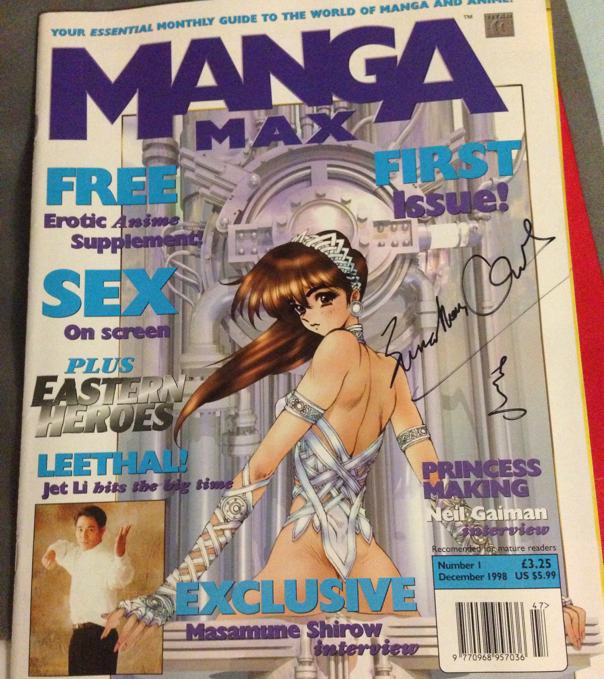
Just to see how completely different things are these days, right?
This is the first issue of UK anime magazine Manga Max, originally published at the back end of 1998 (this is the December issue, which I guess means it came out in November). The reason I have it with me, well, I brought it to accost former-editor (and usual SLA guest announcer) Jonathan Clements with – that’s his autograph you see on the front there.
Manga Max probably has something of a storied history which isn’t really worth getting into in any real depth for the sake of this post – it sprang out of Manga Mania, originally a combination anime magazine and manga anthology published by Dark Horse (as a release vector for the Akira manga, amongst other things), which eventually went through three or four different publishers before landing (back with) Titan. This manga-free relaunch under a different moniker had something to do with trying to expand it’s market outside of the UK.
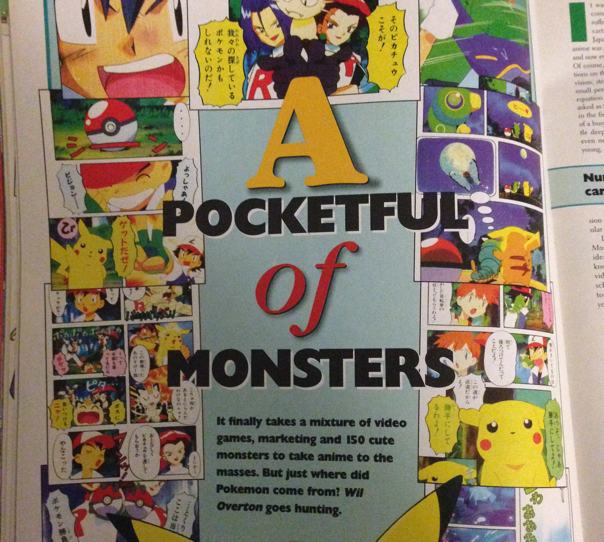
OK, first point of hilarity – this magazine had a feature on Pokemon. This is back when, if memory serves correctly, the anime had broken in the US, but hadn’t yet migrated here to the UK. The article actually refers to the property as Pocket Monsters throughout, something which Nintendo outside of Japan would really rather you not do.
Of course, the latest Pokemon game is released… well, it was supposed to be tomorrow, but most UK retailers ended up breaking release date and started selling it today.
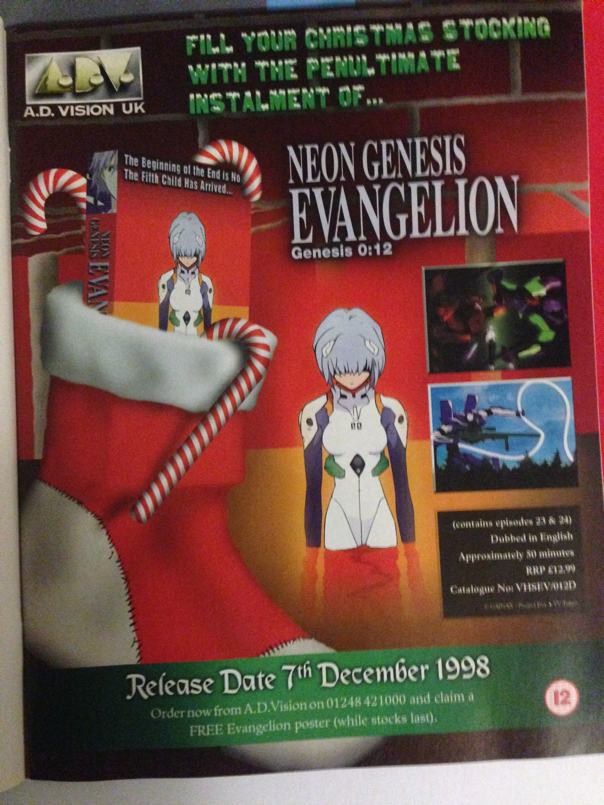
The second-to-last volume of Evangelion was about to be released on VHS – the perfect Christmas present, apparently, which probably also explains the much later US Evangelion special Christmas Edition ADV released. Vaguely amusing today because, errr, I literally about an hour ago got out of the first European screening of Evangelion 3.0 (it was OK, I guess. The Nadia music reuse bugs me as it plays on nostalgia of what is essentially a far better version of the same scene, though).
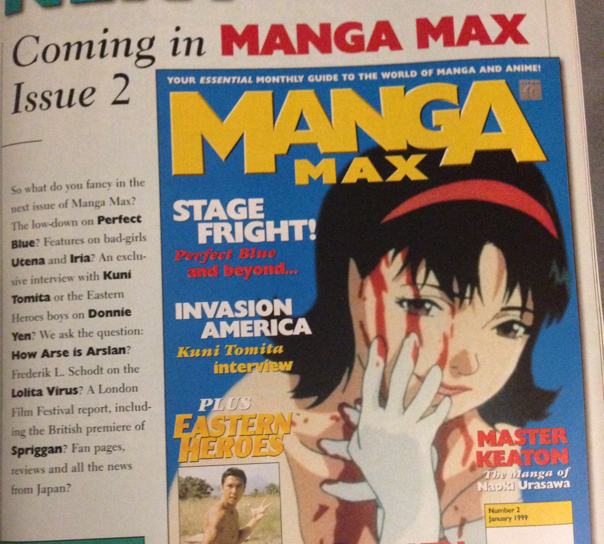
And speaking of movies, the next thing I’m off to see, in about an hour and a half, is Perfect Blue, which was also the subject of the second issue of Manga Max. This was back just before the movie got it’s original UK (theatrical) release – I remember seeing the movie in the cinema the same day as The Matrix, early 1999. Kind of messed with my head for an hour or so, that double bill did. Perfect Blue is about to get a re-release of BD here in the UK next month, after having been out of print for some time now.
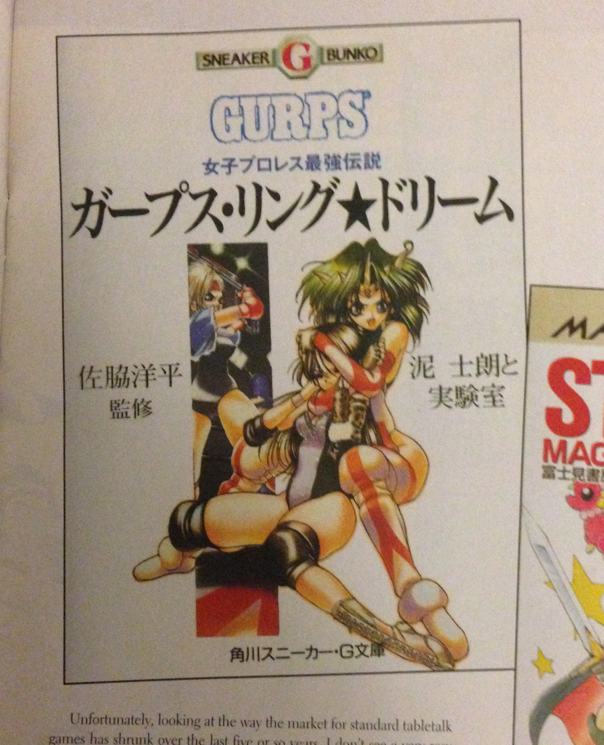
Womens Wrestling…. although this is actually an RPG rule book based on the GURPS system (published on the Sneaker Bunko label, same as Haruhi and the currently airing My Mental Choices are Completely Interfering with my School Romantic Comedy), rather than a manga or anything anime related. Not really amusing in an SLA sense, I guess, but, hey, there is a womens wrestling show airing at the moment, right?
In other things amusing about this issue, Naoki Urasawa is cited as being known for Pineapple Army, the final episode of Giant Robo was, finally, about to be released on VHS, Legend of the Overfiend was scheduled to play on subscription movie channel FilmFour, and, in a credibility-destroying move, two Cowboy Bebop OSTs only score 3/5 in the review section.

2013-10-12
#
As the guy who probably wrote the Naoki Urasawa coverage, he really was unknown in the West at that time other than for Pineapple Army. I recall burbling on in an early issue about Yawara!, Happy! (whose climax was set in the Coral Bookmakers near where I was living at the time) Dancing Policeman and Master Keaton (which was just coming on TV back then). Monster was out in Japan but had not yet earned a Tezuka Award.
What’s amusing now was, in the ’90s, very much the edge of anime and manga journalism in English. Part of the mission was to cover things that had not been talked about in English and avoid parroting Anime company press releases. On the whole i think we did very well.
2013-10-12
#
Oh, yeah, I liked the magazine and read pretty much every issue (the fact that I still have this, and several other issues, should be testament to that) – I didn’t mean to come across as being sarcastic about the Pineapple Army thing, it’s just really, really weird to think of a time when people didn’t think of Urasawa as the guy who wrote Monster or 20th Century Boys.
Admittedly, that’s mostly because I don’t think I read any Urasawa before Monster – come to think about it, I think my first inflection point with anything with his name on it was watching the US releases of the Master Keaton DVDs.
(The Cowboy Bebop OST thing, I stand by, though 🙂 )
2013-10-12
#
Fair enough. Remember, Manga Max appeared a time when there were fewer Japanese-speakers writing on the subject than today, which resulted in a lot of gaps where handwaving charlatans could step in, fat with opinion and short on knowledge, and just Make Up Shit. Certain people built bookwriting careers on this.
Clemmo’s Manga Max was in part a reaction against that, to introduce some sourced information into the discussion. That said, for political reasons we still ended up hiring a few of the charlatans for some pieces, though Jon made sure to fact-check them rigorously and rewrite where they’d filled the piece with guff. The magazine was full of information that English speakers did not know at that time and could not be found on the damned internet.
Manga Max was also an attempt to treat the medium critically, which was not done back then. Trish Ledoux at Viz was keen to ‘love everything, hype everything’ as an attempt to bolster the manga and anime brand. And of course, the fans were (and still are) deeply in love with all sorts of appalling tosh and go tonto when their favourites are disrespected. I recall my review of Revolutionary Girl Utena, where I pointed out the incredibly young demographic of the anime and earned a shitstorm in response.
The fans hated Manga Max because it didn’t pander to them. They often wouldn’t admit they’d read it. We played a game of seeing how swiftly some factoid from the mag would appear on the internet as received wisdom, with the writer claiming he’d read it anywhere except MM. Good fun.
As for Cowboy Bebop, I cannot remember that soundtrack review. Was that ‘Music for Freelance’? We were on the whole huge boosters for the show. There were a number of landmark series we tried to promote, such as Eva, Bebop, Patlabor and Blue Submarine No.6, because they were great, and stood in contrast to the usual juvenile nonsense that the fans frothed about, probably with catgirls in it.
Oh, and that anecdote about Happy! Yes, the climax of the manga occurred at the Coral Bookmakers on Wimbledon Park Road SW18, which bizarrely was just around the corner from me. It made me wonder whether it was Urasawa or one of his assistants who went there to take pics and source the reference for the backgrounds. He seems to be more fascinated with Europe than America, that lad. Though we laughed at the TV Master Keaton’s tendency to paint London as some Mitteleuropean metropolis.
2013-10-12
#
Yeah, I get where you were coming from regarding the magazines content, and it certainly comes across in some of the features you see in the magazine (I can’t imagine seeing a two page feature on a Japan-only Evangelion card game, interesting as it was, in Animerica!). There’s still an awful lot of incorrectly cited mis-information from back in those days which continues to circulate to this day. I’m looking forward to JCs new book for pretty much this kind of reason.
I also remember that Utena review ^^;
As for Bebop, there were two separate reviews of… I think it’s Blue and Vitaminless (at the GFT queing for the mystery film right now, so I don’t have it to hand to check) – they were sandwiching a review of Kanno’s Brain Powerd OST, which, justifiably, got a higher grade, but 3/5 seemed a little harsh.
(Ps – did anyone ever find out what the Japanese for “smeg head” was?)
2013-10-12
#
Yes, I’d better pre-order Jon’s book. I can’t rely on getting a freebie these days.
The Manga Max years were fun and exciting times. We were highlighting new stuff to the mainstream and there were some fabulous moments. I recall getting home one day to find my wife Motoko interviewing Leiji Matsumoto on the ‘phone. The old roué was clearly chatting her up and I wasn’t sure whether to get mad or to dance a little jig.
The Utena review was enormous fun. There were some really ranty responses trying to insist that it was for adults too, honest. I wanted to point out: ‘have you seen the adverts that accompany the TV show?’ or ‘you’ve checked the demographic of Ciao magazine, haven’t you?’ But haters gotta hate, I suppose.
I don’t have a clue what the Japanese is for ‘smeg head’ and I don’t have the nerve to ask the missus.
2013-10-12
#
Well, I like Utena (an awful lot), but I’m fully aware that a lot of the cartoons I watch are either aimed at young children, or are late night shows pretending to be aimed at little kids that are really aimed at people who should know better (that the former tend to be more interesting and ambitious is, perhaps, a little worrying, though).
I do wonder how many people are just wilfully ignorant out of a sense of insecurity about what they’re watching, and how many have just been mislead by ADV stamping promo’s yelling “IT’S NOT KIDS STUFF” on their releases, regardless of actual content. There was some pretty crass, misleading marketing of this stuff 10-15 years back.
2013-10-12
#
There’s a difference between ‘this is kid’s stuff but I like it’ and flat-out denial that such-and-such a show was made for thirteen year-old high school girls. The former view is fine, the latter just baffling defensiveness and, as you say, a product of insecurity.
One of the things Jon did so well then, and still does today, is that he follows the money trail. I could be a big fan of Sailor Moon back in the mid-’90s. But it was so much more interesting when viewed as a vertically-integrated product, building an audience in one demographic and then rebooting when that audience grew too old and moved on. Follow the money and you’ll soon find yourself considering the issues of art and craft that are the consequence of those commercial decisions. Jon does a course on this, and it’s excellent.
2013-10-12
#
That’s certainly not a point of view I can disagree with. Whilst I don’t think it’s necessary to consider that kind of thing to enjoy something for what it is, it certainly can lay a whole additional layer of interest when you take into consider not only the intended audience, but also the purpose and commercial reasoning behind something being made – particularly these days when so much anime is essentially made as paid-for late-night advertisement for either media-mix products or whatever the original work was.
2013-10-13
#
Oh agreed that you don’t need this knowledge to enjoy such a thing. But presumably someone paying for a magazine might well enjoy it. That said, Animerica’s fan-pandering may well indicate that I’m barking up entirely the wrong tree. Maybe the audience *does* want end-to-end cosplay photos, pinup pics and gushing reviews of the latest video dreck.
I like Jon’s talk, that he still gives occasionally, that starts with a manga artist getting his first series and ends with the reason why those fight sequences are smeared thinly across a series of double-page spreads. But there may be a very niche audience for this stuff. Maybe Manga Max’s mistake was targeting that market.
2013-10-13
#
Well, whilst I suppose pandering is a way to build an audience, it’s also an incredibly short-sighted thing to be doing, and we’ve all seen what happens when you overfill the market with a lot of dreck you’re pretending is good with how the US market has played out over the last 6-10 years. All you end up doing is creating an unsustainable bubble.